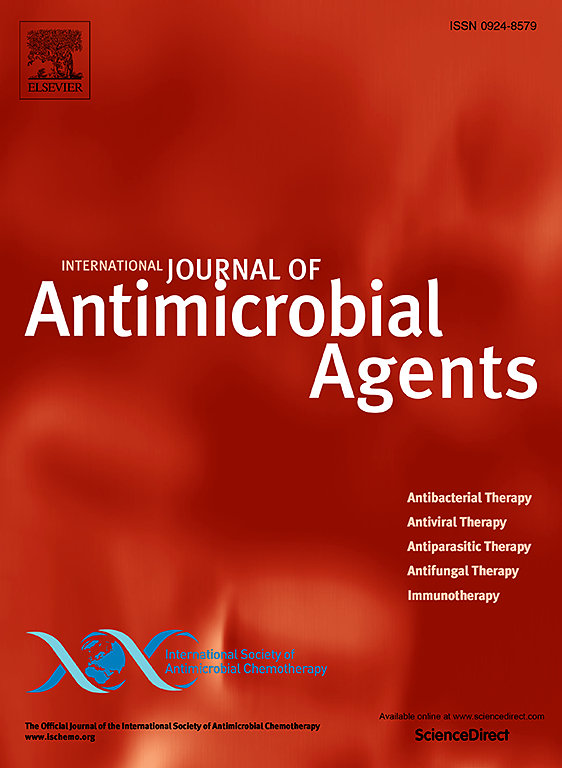Rising threat of metallo-β-lactamase-producing Klebsiella oxytoca complex in Taiwan, 2013–2022
IF 4.9
2区 医学
Q1 INFECTIOUS DISEASES
International Journal of Antimicrobial Agents
Pub Date : 2025-04-15
DOI:10.1016/j.ijantimicag.2025.107515
引用次数: 0
Abstract
Objectives
The emergence of metallo-beta-lactamases (MBLs) within the Klebsiella oxytoca complex (CRKO) poses a significant challenge in Taiwan, with so far incomplete characterization of species distribution and carbapenemase variants. This study aimed to elucidate the diversity, variants, and clinical presentations of CRKO isolates collected from 2013 to 2022.
Methods
We analyzed production of carbapenemases by the modified carbapenem inhibitory method (mCIM) and the NG testTM CARBA-5. Confirmation of five common carbapenemases and multilocus sequence typing were determined by polymerase chain reaction and sequencing. Nanopore whole-genome sequencing was used for the species differentiation and plasmids analysis. We also evaluated the clinical characteristics of the CRKO-infected patients.
Results
Three species were identified: K. michiganensis (n = 102), K. pasteurii (n = 13), and K. oxytoca (n = 3). A majority of isolates (91.5%, n = 108) harbored at least one MBL gene, including blaVIM-1 (n = 56), blaIMP-8 (n = 26), and blaNDM-1 (n = 19), with six isolates carrying dual carbapenemase genes. The blaNDM-1 and blaIMP-8 genes were located on IncFII(Yp) and IncA/C2 plasmids, respectively. Notably, 34.7% of isolates carried kleboxymycin gene clusters (KGC). Using CLSI and EUCAST criteria, 92.4% and 82.4% of isolates, respectively, were susceptible to cefiderocol. Among 92 infected patients, the 30-day mortality rate was 21.7%, associated with female gender, higher Charlson Comorbidity Index, higher Pitt bacteremia scores, presence of bacteremia, and inversely associated with KGC.
Conclusion
The high prevalence of CRKO carrying MBLs and the recent surge of the ST27-blaNDM-1 genotype, poses significant treatment challenges and underscores the urgent need for enhanced surveillance in Taiwan.

产金属β-内酰胺酶的产氧克雷伯菌复合体在台湾的威胁上升,2013-2022
在台湾,氧化克雷伯菌复合体(CRKO)中金属β -内酰胺酶(MBLs)的出现带来了重大挑战,迄今为止物种分布和碳青霉烯酶变异的特征尚不完整。本研究旨在阐明2013年至2022年收集的CRKO分离株的多样性、变异和临床表现。方法采用改良碳青霉烯类酶抑制法(mCIM)和碳青霉烯类酶检测法(CARBA-5)对碳青霉烯类酶的合成进行分析。采用聚合酶链反应和测序法对5种常见的碳青霉烯酶进行鉴定和多位点序列分型。采用纳米孔全基因组测序进行物种分化和质粒分析。我们还评估了crko感染患者的临床特征。结果共鉴定出3种病原菌,分别为密歇根乳杆菌102种、巴氏乳杆菌13种和oxytoca乳杆菌3种。大多数分离株(91.5%,n = 108)至少携带1个MBL基因,包括blaVIM-1 (n = 56)、blaIMP-8 (n = 26)和blaNDM-1 (n = 19), 6株分离株携带双碳青霉烯酶基因。blaNDM-1和blaIMP-8基因分别位于IncFII(Yp)和IncA/C2质粒上。值得注意的是,34.7%的分离株携带克雷霉素基因簇(KGC)。采用CLSI和EUCAST标准,分别有92.4%和82.4%的菌株对头孢地罗敏感。92例感染患者30天死亡率为21.7%,与女性、较高的Charlson合并症指数、较高的Pitt菌血症评分、存在菌血症相关,与KGC呈负相关。结论CRKO携带MBLs的高流行率和近期ST27-blaNDM-1基因型的激增,给台湾的治疗带来了重大挑战,并强调了加强监测的迫切需要。
本文章由计算机程序翻译,如有差异,请以英文原文为准。
求助全文
约1分钟内获得全文
求助全文
来源期刊
CiteScore
21.60
自引率
0.90%
发文量
176
审稿时长
36 days
期刊介绍:
The International Journal of Antimicrobial Agents is a peer-reviewed publication offering comprehensive and current reference information on the physical, pharmacological, in vitro, and clinical properties of individual antimicrobial agents, covering antiviral, antiparasitic, antibacterial, and antifungal agents. The journal not only communicates new trends and developments through authoritative review articles but also addresses the critical issue of antimicrobial resistance, both in hospital and community settings. Published content includes solicited reviews by leading experts and high-quality original research papers in the specified fields.

 求助内容:
求助内容: 应助结果提醒方式:
应助结果提醒方式:


